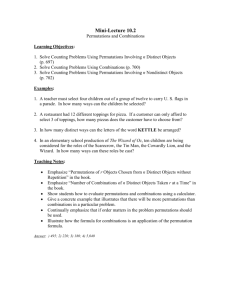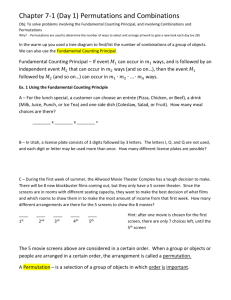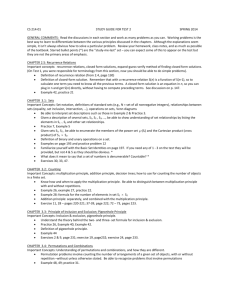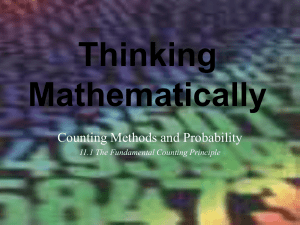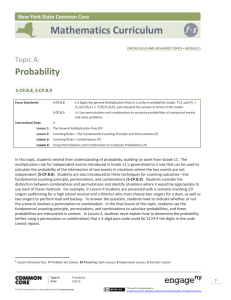Transitioning to Iowa Core Mathematics (S
advertisement
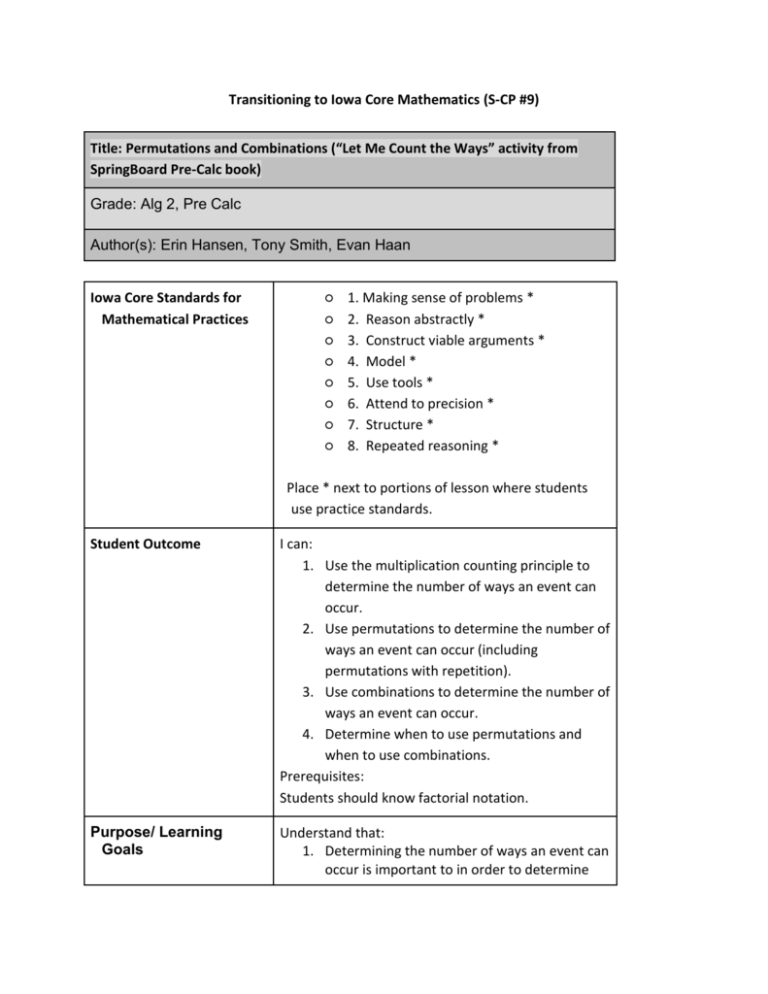
Transitioning to Iowa Core Mathematics (S-CP #9) Title: Permutations and Combinations (“Let Me Count the Ways” activity from SpringBoard Pre-Calc book) Grade: Alg 2, Pre Calc Author(s): Erin Hansen, Tony Smith, Evan Haan Iowa Core Standards for Mathematical Practices ○ ○ ○ ○ ○ ○ ○ ○ 1. Making sense of problems * 2. Reason abstractly * 3. Construct viable arguments * 4. Model * 5. Use tools * 6. Attend to precision * 7. Structure * 8. Repeated reasoning * Place * next to portions of lesson where students use practice standards. Student Outcome I can: 1. Use the multiplication counting principle to determine the number of ways an event can occur. 2. Use permutations to determine the number of ways an event can occur (including permutations with repetition). 3. Use combinations to determine the number of ways an event can occur. 4. Determine when to use permutations and when to use combinations. Prerequisites: Students should know factorial notation. Purpose/ Learning Goals Understand that: 1. Determining the number of ways an event can occur is important to in order to determine probabilities. 2. Counting and probability are important for making decisions about the future based on past patterns. 3. Permutation and combinations is a way of counting the number of ways an event can occur in an organized way. Grouping Strategies Work with a group of three to complete the task. LESSON SEQUENCE (Include plans for adjustments to accommodate all learners) Launch Activities Discuss the purpose and importance of counting and probability. Discuss independent and dependent events. Notes Counting problems are of the following kind: How many different 8-letter passwords are there? How many possible ways are there to pick 11 soccer players out of a 20-player team? Most importantly, counting is the basis for computing probabilities of events. Ex: What is the probability of winning the lottery? Events are independent if one event does not affect the other. Ex: Roll a die two times Events are dependent if one Materials event does affect the other (one event depends on another). Ex: Drawing two names out of a hat Explore Activities Notes Materials Day 1 Complete Part I and II. Students work with the multiplication counting principle. Day 1 The concept of detour-prone and false detour-prone zip codes may be challenging for some students. “Let Me Count the Ways” activity sheet. Calculator. Day 2 Complete Part III. Students explore the concept of permutations and indistinguishable permutations. Day 2 After students learn the formula for permutations, show them how to access permutations on their calculator. Guide the students through #16f,g as a class. Day 3 Complete Part IV. Students explore the concept of combinations and distinguish between permutations and combinations. Day 3 Guide the students through #19d,e. After students learn the formula for combinations, show them how to access combinations on their calculator. Summarize Activities Notes Day 1 Day 1 Have a few groups share their zip How many 5 digit non-detourcode work. prone zip codes are possible? Checking for Understanding (CFU): How did you arrive at this Give an example of a problem answer? that can be solved with the What are some other possible multiplication counting applications of the principle. Explain how the multiplication counting multiplication counting principle? principle works for this example. Day 2 Discuss permutations as a class. CFU: There are 10 names on the ballot for class officers. If all 10 can fill any position, how many ways can a president, vice president, secretary, and treasurer be chosen? Can a permutation be used to determine how many ways 4 people can be chosen for a committee? Explain. Day 2 When is a permutation used? Why is it important to be able to count indistinguishable permutations? Day 3 Discuss the difference between permutations and combinations. CFU: Give an example for which a combination can be used. Give an example for which a permutation can be used. Day 3 When is a combination used? How is a combination different from a permutation? Materials “Let Me Count the Ways” activity sheet. Calculator.

